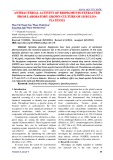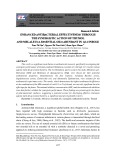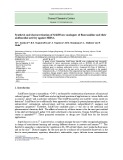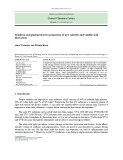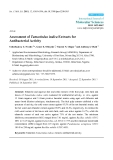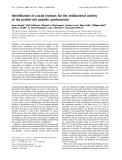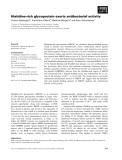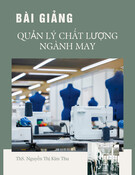
Academic Editors: Thomas J. Schmidt
and Enrique Barrajón-Catalán
Received: 3 December 2024
Revised: 3 January 2025
Accepted: 29 January 2025
Published: 31 January 2025
Citation: Kirkova, D.; Stremski, Y.;
Bachvarova, M.; Todorova, M.;
Goranov, B.; Statkova-Abeghe, S.;
Docheva, M. New
Benzothiazole–Monoterpenoid
Hybrids as Multifunctional Molecules
with Potential Applications in
Cosmetics. Molecules 2025,30, 636.
https://doi.org/10.3390/
molecules30030636
Copyright: © 2025 by the authors.
Licensee MDPI, Basel, Switzerland.
This article is an open access article
distributed under the terms and
conditions of the Creative Commons
Attribution (CC BY) license
(https://creativecommons.org/
licenses/by/4.0/).
Article
New Benzothiazole–Monoterpenoid Hybrids as Multifunctional
Molecules with Potential Applications in Cosmetics
Desislava Kirkova 1, Yordan Stremski 2,* , Maria Bachvarova 2, Mina Todorova 2, Bogdan Goranov 3,
Stela Statkova-Abeghe 2and Margarita Docheva 1
1Agricultural Academy, Tobacco and Tobacco Products Institute, 4108 Markovo, Bulgaria;
desislavaa894@gmail.com (D.K.); margarita_1980@abv.bg (M.D.)
2Department of Organic Chemistry, University of Plovdiv “Paisii Hilendarski”, 24 Tsar Asen Str.,
4000 Plovdiv, Bulgaria; bychvarova@uni-plovdiv.bg (M.B.); minatodorova@uni-plovdiv.bg (M.T.);
stab@uni-plovdiv.bg (S.S.-A.)
3Department of Microbiology and Biotechnology, University of Food Technologies, 26 Maritza Boulevard,
4002 Plovdiv, Bulgaria; b_goranov@uft-plovdiv.bg
*Correspondence: stremski@uni-plovdiv.net; Tel.: +359-32-261-346
Abstract: The Thymus vulgaris and Origanum vulgare essential oils (contained thymol and
carvacrol in a range of 35–80%) are used in various products in the fields of medicine,
cosmetics, and foods. Molecular hybridization between benzothiazole (BT) and phe-
nolic monoterpenoids is a promising method for the development of biologically ac-
tive compounds. New benzothiazole–monoterpenoid hybrids were synthesized through
a regioselective
α
-amidoalkylation reaction of thymol and carvacrol with high yields
(70–96%). This approach is both simple and cost-effective, employing easily accessi-
ble and inexpensive reagents to produce target molecules. The structure of the synthe-
sized compounds was characterized spectrally using
1
H-,
13
C-NMR, FT-IR, and HRMS
data. The newly obtained compounds are structural analogues of the UVB filter PBSA,
which is used in cosmetics. The spectral properties of the aromatic products thymol
hybrid (2-(4-hydroxy-5-isopropyl-2-methylphenyl)benzo[d]thiazole) and carvacrol hy-
brid (2-(4-hydroxy-2-isopropyl-5-methylphenyl)benzo[d]thiazole) were successfully ex-
amined, using a validated spectrophotometric method. SPF values varied from 31 to
36, compared to the PBSA (30), and were observed at concentrations of 1–0.25 mM.
2-Hydroxyphenylbenzothiazoles
are known antimicrobial and antioxidant agents that have
potential applications in the food industry and cosmetics as preservatives and antioxidants.
In this context, antimicrobial activity of the hybrid compounds was evaluated using the
agar diffusion method against E. coli,S. aureus,P. aeruginosa, and C. albicans. Compounds of
methyl-2-(4-hydroxy-2-isopropyl-5-methylphenyl)benzo[d]thiazole-3(2H)-carboxylate con-
taining carvacrol fragments showed high activity against Staphylococcus aureus ATCC 25923
(with 0.044
µ
mol content). The radical scavenging activity was determined using ABTS and
DPPH assays, the highest activity was exhibited by the thymol hybrids ethyl-2-(4-hydroxy-
5-isopropyl-2-methylphenyl)benzo[d]thiazole-3(2H)-carboxylate (IC
50
—133.70
±
10
µ
M)
and methyl-2-(4-hydroxy-5-isopropyl-2-methylphenyl)benzo[d]thiazole-3(2H)-carboxylate
(IC
50
—157.50
±
10
µ
M), defined by ABTS. The aromatic benzothiazole–monoterpenoid
hybrids are classified using in silico analyses as non-mutagenic, with low toxicity, and they
are non-irritating to the skin. These compounds were identified as new hit scaffolds for
multifunctional molecules in cosmetics.
Keywords:
α
-amidoalkylation; molecular hybridization; thymol; carvacrol; in silico
predictions; sun-protection factor; PBSA; antimicrobial activity
Molecules 2025,30, 636 https://doi.org/10.3390/molecules30030636






